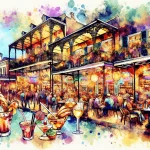A focal point of New Orleans’ Mid-City neighborhood, Bayou St. John embodies the city’s storied past and cultural identity. This 4.7-mile picturesque waterway has been instrumental in shaping the development of New Orleans since its earliest days.
In This Article
TL;DR
- Bayou St. John has played a pivotal role in New Orleans’ growth, serving as a vital transportation route and cultural hub since the city’s founding.
- The bayou is now a gathering place for the Mid-City community, offering recreation, relaxation, and cultural celebrations that bring residents together.
- Visitors can enjoy activities like kayaking, paddleboarding, and attending festivals like Bayou Boogaloo and Praise Fest, which celebrate the area’s unique heritage.
Historical Overview of Bayou St. John
The history of Bayou St. John stretches back thousands of years, with evidence of indigenous settlements along its banks as early as 400 BC. In the 18th century, French explorers recognized its strategic location for trade and settlement.
In 1718, French-Canadian explorer Jean-Baptiste Le Moyne de Bienville established New Orleans along Bayou St. John, recognizing its importance as a natural outlet to Lake Pontchartrain and the Gulf of Mexico. The bayou served as the primary transportation route between the lake and the Mississippi River, contributing to the city’s rapid growth.
Throughout the 18th and 19th centuries, Bayou St. John witnessed significant events shaping New Orleans’ history, including the American Revolutionary War and the Battle of New Orleans during the War of 1812.
Geographical and Environmental Aspects
Bayou St. John is a natural waterway extending from Lake Pontchartrain to the French Quarter, winding through Mid-City New Orleans. Its calm, shallow waters are bordered by lush vegetation, providing habitat for diverse wildlife.
The bayou is home to various aquatic species and bird species, creating a serene oasis within the bustling city. However, urban development has impacted the bayou’s ecosystem over the years, leading to conservation efforts aimed at preserving and restoring its natural environment.
Cultural Significance
Bayou St. John has long been a cultural hub for the Mid-City neighborhood, serving as a gathering place for residents and backdrop for numerous festivals and events celebrating the area’s unique heritage. The bayou’s banks have hosted Voodoo ceremonies, jazz performances, and community celebrations for generations.
Bayou Boogaloo
One of the most notable cultural events is the annual Bayou Boogaloo festival, a three-day music and arts festival featuring live performances, food vendors, and an art market. The festival attracts thousands of visitors each year and celebrates the bayou’s role in the community.
Other Cultural Events
Other cultural events along Bayou St. John include Praise Fest, a gospel music festival, and the Mid-City Bayou Boogaloo, a smaller neighborhood festival focused on local music and art. These events showcase the diversity and creativity of the Mid-City community, highlighting the bayou’s importance as a cultural landmark.
Recreational Activities
Bayou St. John offers a wide range of recreational activities, including kayaking, canoeing, paddleboarding, fishing, picnicking, jogging, and cycling. Local outfitters provide rentals and guided tours, while community organizations promote and maintain the recreational opportunities along the bayou.
Popular spots for water activities include the Bayou St. John Paddle Launch and the Bayou St. John Kayak Launch, while anglers often fish near the Orleans Avenue Bridge and the Esplanade Avenue Bridge. The Wisner Bike Path, running along the bayou, offers scenic views for cyclists and joggers.
Community and Lifestyle
The neighborhoods surrounding Bayou St. John, particularly Mid-City and Faubourg St. John, are known for their strong sense of community and unique lifestyle. Residents take pride in preserving the area’s architectural heritage, and the bayou plays a central role in daily life as a gathering place for socializing, relaxing, and enjoying the outdoors.
The presence of Bayou St. John influences the local economy, with businesses catering to residents and visitors alike. Restaurants, cafes, and bars along the bayou offer outdoor seating with views of the water, creating a unique dining and socializing experience, while local shops and galleries showcase the work of regional artists and craftspeople.
Community-led conservation efforts have played a significant role in preserving and enhancing Bayou St. John, ensuring it remains a vital part of the community for generations to come.
Architectural Highlights
The neighborhoods surrounding Bayou St. John are home to a variety of architectural styles, reflecting the area’s rich history and cultural influences. Notable landmarks include the Pitot House, a beautiful 18th-century Creole colonial plantation home, and the Beaux-Arts-style New Orleans Museum of Art (NOMA) in City Park.
Preservation efforts by organizations like the Faubourg St. John Neighborhood Association have helped maintain the unique charm and sense of place that define the neighborhoods along Bayou St. John.
Future Prospects and Ongoing Projects
Several ongoing projects aim to improve and preserve Bayou St. John. The Bayou St. John Water Management Strategy includes initiatives to address water quality, stormwater management, and ecosystem health, while the Lafitte Greenway provides a safe and accessible route connecting the bayou to the French Quarter.
These projects are expected to enhance the bayou’s ecological function, increase its resilience to climate change, and provide new opportunities for residents and visitors to engage with the waterway. As these projects continue, they will have a profound impact on the neighborhoods surrounding Bayou St. John, improving quality of life and ensuring this historic waterway remains a vital part of New Orleans’ landscape.
Bayou St. John stands as a testament to the resilience, creativity, and spirit of the people of New Orleans. Through centuries of change, this remarkable waterway has endured, adapting to the needs of the community while preserving its essential character and charm. As the city looks to the future, Bayou St. John will undoubtedly continue to play a central role in shaping the identity and vitality of Mid-City and beyond, reminding us of the enduring power of place and the importance of protecting and celebrating our shared heritage.






